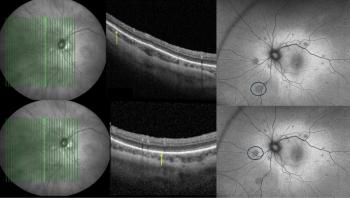
Anterior juxtascleral depot of anecortave acetate reduces IOP significantly
IOP can be reduced significantly by an anterior juxtascleral depot of anecortave acetate, according to study results presented on a poster at this year's meeting of the Association for Research in Vision and Ophthalmology.
IOP can be reduced significantly by an anterior juxtascleral depot of anecortave acetate, according to study results presented on a poster at this year's meeting of the Association for Research in Vision and Ophthalmology.
Tiago S. Prata, MD conducted a prospective, non-randomized open-labelled trial on 25 eyes of uncontrolled glaucoma patients with a mean IOP of 30.9±9.2 mmHg. Dr Prata injected a single anterior juxtascleral depot of 30 mg of anecortave acetate and then assessed the eyes for the following three months. No major complications were recorded.
Mean IOP decreased to 20.9±7.5 mmHg at the first month. At the second month, IOP had increased slightly to 21.5±7.6 mmHg; in the third month, mean IOP dropped again to 19.1±5.2 mmHg.
Thus the researchers concluded that a single injection of anecortave acetate was sufficient to reduce IOP for a period of at least three months.
Newsletter
Get the essential updates shaping the future of pharma manufacturing and compliance—subscribe today to Pharmaceutical Technology and never miss a breakthrough.













































